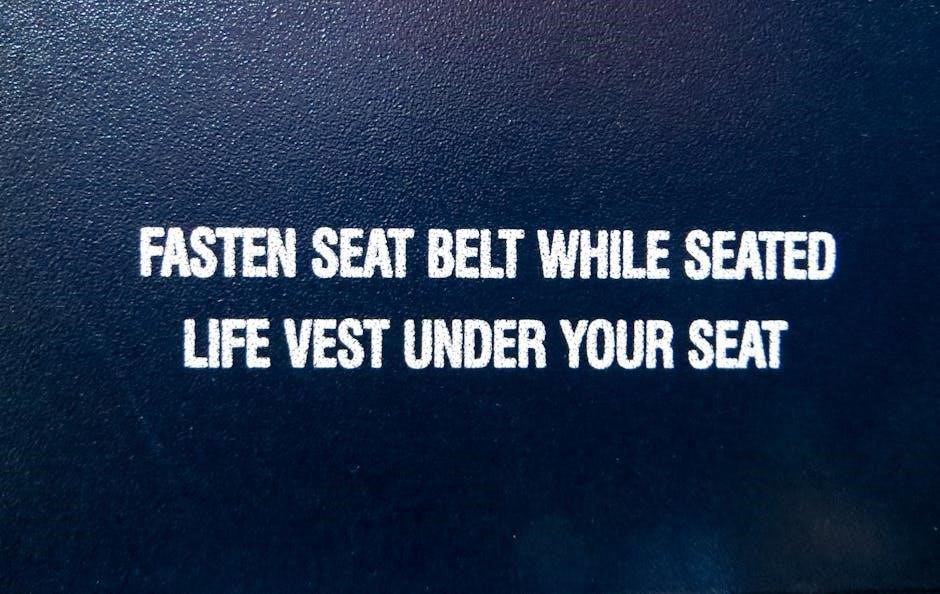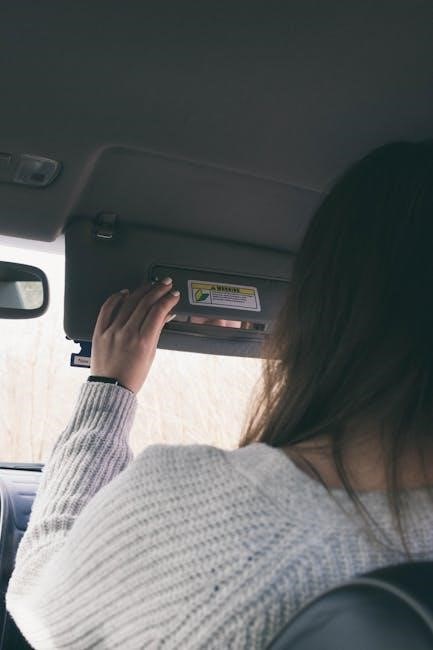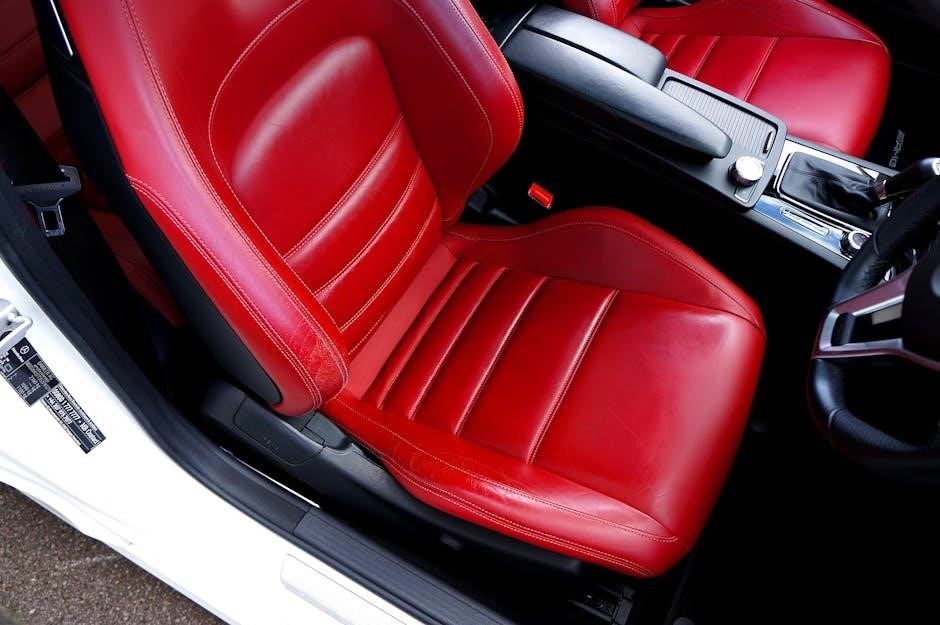Welcome to our comprehensive guide on Safety 1st car seat instructions. Proper installation and use are critical for ensuring your child’s safety while traveling. This guide will walk you through key features, installation steps, and safety tips to help you make informed decisions.
1.1 Importance of Car Seat Safety
Car seat safety is paramount to protect children from injury or fatality in vehicle accidents. Proper installation and use ensure optimal protection, reducing risks by up to 70%. Recent recalls highlight potential hazards, such as choking risks from defective parts, emphasizing the need for adherence to safety guidelines and regular inspections. Stay informed about recalls and follow manufacturer instructions to safeguard your child’s well-being on the road.
1.2 Overview of Safety 1st Car Seats
Safety 1st offers a range of car seats designed for comfort, convenience, and safety. Models like the onBoard 35 Secure Tech and Grow and Go Sprint provide all-in-one solutions, adapting to a child’s growth. Features include sliding bases for easy installation and advanced side impact protection. However, recent recalls, such as those affecting headrest foam pads, remind users to stay vigilant and ensure their seats are up-to-date with safety standards.

Choosing the Right Car Seat
Selecting the right car seat involves considering your child’s age, size, and weight. Safety 1st offers infant, convertible, and all-in-one seats, each catering to different needs. Factor in features like adjustable bases for proper fit and expiration dates to ensure long-term safety and compliance with safety standards.
2.1 Types of Car Seats (Infant, Convertible, All-in-One)
Safety 1st car seats come in three primary types: infant, convertible, and all-in-one. Infant seats are designed for newborns up to 35 pounds, offering portability and ease of use. Convertible seats transition from rear-facing to forward-facing, accommodating children up to 65 pounds. All-in-one seats adapt from rear-facing to forward-facing to booster, providing long-term use for children up to 120 pounds. Each type ensures proper fit and safety as your child grows.
2.2 Size and Weight Limits for Safety 1st Car Seats
Safety 1st car seats have specific size and weight limits to ensure proper fit and safety. Infant seats typically accommodate children up to 35 pounds, while convertible and all-in-one seats support up to 65-120 pounds, depending on the model. Adhering to these limits is crucial for optimal protection. Always check your car seat’s manual for exact specifications, as exceeding weight or height limits can compromise safety and effectiveness in the event of a crash.
2.3 Expiration Dates and When to Replace
Safety 1st car seats, like most models, come with expiration dates, typically ranging from 6 to 10 years after manufacture; These dates ensure materials remain durable and meet current safety standards. Always check the manual or seat label for the exact expiration date. Replace the seat immediately if it expires, has been in a crash, or shows signs of wear. This ensures your child’s continued safety and protection while traveling.

Understanding Car Seat Components
Safety 1st car seats typically expire 6-10 years after manufacture. Check the manual or seat label for the exact date. Replace immediately if expired, damaged, or after a crash to ensure safety and compliance with current standards.
3.1 Base Installation Features
The base of a Safety 1st car seat is designed for secure installation in your vehicle. It features a LATCH system for easy attachment to car anchors, ensuring a snug fit. A built-in level helps achieve the correct angle, while a sliding base in some models allows for easier positioning. These features work together to provide a stable and safe foundation for your child’s car seat, minimizing movement and enhancing protection during travel.
3.2 Seat and Harness System
The seat and harness system of Safety 1st car seats are designed for optimal safety and comfort. The seat features cushioning and breathable fabric to keep your child comfortable during long trips. The harness system includes adjustable straps and a chest clip to ensure proper fit. It also has padding on the shoulders and hips for added comfort. The harness is designed to distribute crash forces evenly, protecting your child in the event of an impact.
3.3 Canopy and Side Impact Protection
The Safety 1st car seat features a canopy designed to shield your child from sunlight and provide comfort. It also includes advanced side impact protection, with reinforced materials and energy-absorbing technology to safeguard your child in the event of a collision. These features work together to ensure maximum safety and comfort, giving parents peace of mind during travel.

Installation Guidelines
Proper installation is key for Safety 1st car seats. Use the sliding base for easier setup and ensure a secure fit. Always follow both car seat and vehicle manuals for correct installation.
4.1 Vehicle Compatibility and Seat Positioning
Ensure your Safety 1st car seat is compatible with your vehicle. Check both manuals for guidance. Position the seat in the back seat, ideally in the center, for optimal safety. Use the sliding base feature for easier installation and better access. Proper alignment and secure placement are crucial to prevent movement during travel. Always verify the seat’s position and compatibility before use to guarantee your child’s protection.
4.2 Rear-Facing vs. Forward-Facing Installation
Rear-facing installation is safer for infants and toddlers, as it better protects the head and neck in a crash. Use this mode until your child reaches the seat’s weight or height limit. Forward-facing is for older children who outgrow rear-facing. Ensure the seat is tightly secured and the harness is snug. Always follow Safety 1st guidelines for transitioning between modes to maximize protection.
4.3 Using Seat Belt vs. LATCH System
Both seat belts and the LATCH system are safe for installing car seats, but they serve different needs. The LATCH system offers easier, more consistent installation, reducing the risk of incorrect use. Seat belts provide flexibility and are ideal for vehicles without LATCH anchors. Always ensure a snug, tight fit regardless of the method. Follow Safety 1st guidelines for compatibility and consult your vehicle’s manual for specific instructions.

Safety Standards and Certifications
Safety 1st car seats meet rigorous federal safety standards, ensuring protection in crashes. They undergo crash testing and certification processes to guarantee reliability and effectiveness for child safety.
5.1 Federal Safety Standards for Car Seats
Federal safety standards for car seats, regulated by the National Highway Traffic Safety Administration (NHTSA), ensure car seats meet rigorous crash performance requirements. These standards mandate that car seats must withstand crash forces, protect children from injury, and reduce the risk of fatality. Safety 1st car seats are designed to comply with Federal Motor Vehicle Safety Standard (FMVSS) 213, which includes testing for frontal and side-impact crashes. Adherence to these standards is critical for ensuring child safety and is enforced through rigorous testing and certification processes.
5.2 Crash Testing and Safety Ratings
Crash testing evaluates car seats’ performance in simulated collisions, ensuring they protect children effectively. Safety ratings are determined by NHTSA’s 5-star system, assessing crashworthiness and ease of use. Safety 1st car seats undergo rigorous testing for frontal and side impacts, with ratings reflecting their ability to minimize injury risks. Higher ratings indicate better performance, guiding parents in making informed choices to maximize their child’s safety while traveling.
5.3 Why Safety Certifications Matter
Safety certifications ensure car seats meet rigorous federal and international standards, providing parents with confidence in their product’s reliability. These certifications verify that the seat has passed extensive crash testing, ensuring optimal protection for children. They also guarantee compliance with safety regulations, reducing the risk of defects and enhancing overall safety. Always look for certifications from trusted organizations like NHTSA or the Federal Aviation Administration when selecting a car seat.

Common Mistakes to Avoid
Incorrect installation, loose harnesses, and using aftermarket products are frequent errors that compromise safety. Always follow the manual and avoid these pitfalls to protect your child.
6.1 Incorrect Installation Methods
One of the most critical mistakes is improper car seat installation. Using a loose seat belt or incorrect LATCH system can compromise safety. Ensure the base is snug, and the seat belt is tightly secured. Misaligned harness straps or a poorly fitted base can lead to inadequate protection in a crash. Always follow the manufacturer’s instructions to avoid such errors, as they can jeopardize your child’s safety on the road.
6.2 Loose Harness or Chest Clip
A loose harness or improperly positioned chest clip can endanger your child. Ensure the harness is snug, with no slack, and the chest clip is at armpit level. A loose fit can cause excessive movement during a crash. Always check the harness and chest clip before each trip. If the harness is too loose, it may fail to restrain your child effectively, increasing the risk of injury. Consult the manual or a certified technician if unsure, and be aware of recalls related to such issues, such as the recent choking hazard concerns with headrest foam pads.
6.3 Improper Use of Aftermarket Products
Using unapproved aftermarket accessories can compromise your car seat’s safety. Avoid adding padding, toys, or other items not certified by the manufacturer, as they may interfere with the harness or structural integrity. Such modifications can void warranties and increase crash risks. Stick to manufacturer-approved products and follow installation guidelines to ensure optimal protection. Additionally, be aware of recalls, such as those related to headrest foam pads, to maintain your child’s safety.

Car Seat Recalls and Updates
Stay informed about car seat recalls and updates to ensure your child’s safety. Regularly check the NHTSA website for recall notices and follow manufacturer instructions.
7.1 How to Check for Recalls
To check for car seat recalls, visit the NHTSA website and enter your car seat’s model number or brand. You can also sign up for recall alerts from manufacturers. Additionally, check your car seat for a label with the model number and date of manufacture. Regular checks ensure your seat meets safety standards and isn’t part of any ongoing recalls.
7.2 Recent Safety 1st Car Seat Recalls
Recent recalls include the Safety 1st onBoard 35 Secure Tech and Grow and Go Sprint All-in-One seats due to potential choking hazards from headrest foam pads. Dorel has issued free repair kits for affected models. Parents should check their seats against recall lists and contact the manufacturer promptly to ensure their child’s safety is maintained during travel.
7.3 Role of NHTSA in Car Seat Safety
The National Highway Traffic Safety Administration (NHTSA) plays a crucial role in ensuring car seat safety by setting federal standards and monitoring recalls. They provide resources for parents, such as recall notifications and installation tips, to help keep children safe while traveling. Regular updates and safety ratings from NHTSA assist consumers in making informed decisions about car seat purchases and usage.

Maintenance and Care
Regular cleaning and proper storage are essential for maintaining your Safety 1st car seat. Always use mild soap and water to avoid damaging materials. Allow the seat to air dry completely after cleaning to prevent mold or mildew buildup. Store the seat in a cool, dry place when not in use to ensure longevity and safety.
8.1 Cleaning the Car Seat
Cleaning your Safety 1st car seat is crucial for hygiene and safety. Use mild soap and warm water on removable fabric and harnesses. Avoid harsh chemicals or bleach, as they can damage materials. Gently scrub away stains and allow everything to air dry. For non-removable parts, dampen a cloth and wipe down surfaces. Never submerge the seat in water, as this can compromise its structural integrity and safety features. Regular cleaning ensures a safe and comfortable environment for your child.
8.2 Storage and Transportation Tips
Store your Safety 1st car seat in a cool, dry place away from direct sunlight and moisture. Avoid basements or attics due to humidity and temperature fluctuations. When transporting, use the built-in carrying handle for convenience. If the seat is not in use, ensure it is secured to prevent movement. Never leave the car seat in an unattended vehicle, especially in extreme heat, as this can degrade materials. Always inspect the seat for damage before reinstalling it.
8.3 When to Replace the Car Seat
Replace your Safety 1st car seat if it has been involved in a crash, shows signs of wear, or has exceeded its expiration date. Always check for recalls, as some models may require replacement due to safety concerns. Additionally, if the seat’s materials degrade or the harness no longer fits properly, it’s time for a new one. Ensure your child’s safety by adhering to the manufacturer’s guidelines and recommendations.

Weight and Height Limits
Understand the maximum weight and height limits for your Safety 1st car seat to ensure proper fit and safety; Exceeding these limits can compromise protection, necessitating replacement.
9.1 Maximum Weight Capacity
The maximum weight capacity for Safety 1st car seats varies by model, typically ranging from 40 to 120 pounds. Always check the specific seat’s label or manual for precise limits. Exceeding this capacity can reduce safety effectiveness. Parents should monitor their child’s growth and transition to a booster seat when the weight limit is reached. Proper adherence ensures optimal protection during travel.
9.2 Height Restrictions and Adjustments
Safety 1st car seats have specific height limits, typically up to 49 inches, depending on the model. Adjustments are crucial for proper fit; ensure the harness is at or below shoulder level and the seat’s headrest is positioned correctly. Regularly check your child’s growth and adjust the seat accordingly. Proper height alignment ensures optimal protection and comfort, preventing potential safety risks during travel.
9.4 Transitioning to a Booster Seat
Transitioning to a booster seat occurs when your child exceeds the car seat’s height or weight limits, typically around 4-7 years old. Ensure the booster is compatible with your vehicle’s seat belt system. Always follow Safety 1st guidelines for proper installation and fit. Booster seats provide essential support until your child can safely use a vehicle seat belt alone, enhancing their protection during travel.

Tips for Parents
Always read and follow Safety 1st car seat manuals carefully. Ensure proper fit and installation. Regularly check for recalls and updates to maintain your child’s safety while traveling.
10.1 Reading the Manual Thoroughly
Reading the Safety 1st car seat manual is essential for proper installation and use. It provides detailed instructions, safety guidelines, and specific features of your car seat model. Understanding the manual ensures you can address any recalls or updates, like the recent Grow and Go Sprint recall, and use the seat correctly. Take time to review it carefully to maximize your child’s protection.
10.2 Checking for Proper Fit
Ensure your child’s Safety 1st car seat fits correctly in your vehicle. Check the seat’s base for a snug, level installation, and verify the harness straps are secure without slack. The chest clip should be at armpit level, and the seat belt or LATCH system must be properly engaged. Regularly inspect for loose connections and adjust as your child grows to maintain optimal safety and protection.
10.3 Using Safety 1st Resources
Take advantage of Safety 1st’s official resources for guidance. Their website offers detailed manuals, installation videos, and recall information. Utilize their customer support for any questions and register your car seat to receive updates. Additionally, the NHTSA provides recall alerts and safety tips, ensuring you’re informed about the latest updates and best practices for your child’s car seat safety.
Ensuring your child’s safety starts with proper car seat installation and regular checks. Stay informed, follow guidelines, and utilize Safety 1st resources for a secure traveling experience.
11.1 Summarizing Key Safety Practices
Always follow Safety 1st car seat instructions for proper installation, ensuring a snug fit and correct positioning. Regularly inspect the seat for damage or wear. Keep the harness tight, with the chest clip at armpit level. Adhere to weight and height limits, and replace the seat after its expiration date or in case of any recall. Stay vigilant and updated on safety guidelines to protect your child.
11.2 Encouraging Ongoing Vigilance
Stay proactive about your child’s car seat safety by regularly checking for recalls, reading updates, and inspecting the seat for wear. Ensure proper installation and harness fit every time. Familiarize yourself with Safety 1st guidelines and stay informed about new safety standards. By being vigilant, you can help protect your child from potential hazards and ensure their continued safety on the road.
